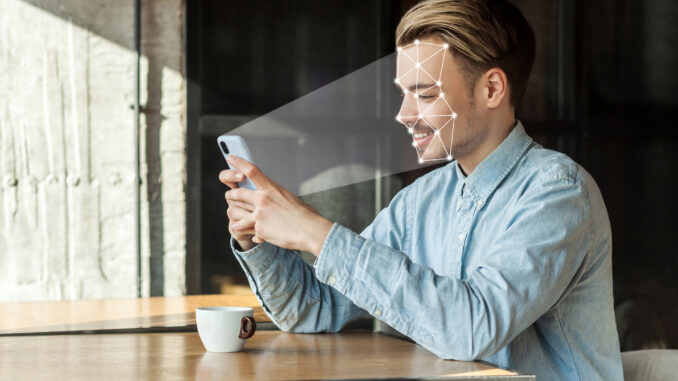
By Jori Hamilton - 11.17.2020
Many industries today are figuring out the best ways to not only survive, but thrive. Restaurants have pivoted in a number of ways, and those shifts will create lasting practices across the industry.
Biometrics, a technology that uses unique physical characteristics like fingerprints or facial features to automatically trigger recognition of a subject, may have started as a high-tech security practice but has turned into something we may soon see in many aspects of our daily lives.
Technology can address many restaurant challenges. In the restaurant industry, tech applications can help improve customer service, security, and restaurant processes. With facial or fingerprint recognition, a restaurant could curate a menu for you as soon as you walk in the door. You could walk out the door without ever pulling out your credit card because the restaurant POS system recognizes your face (and therefore your pre-authorized credit card). You could order without ever talking to a person.
A number of POS systems already have biometrics technology built in, including fingerprint readers for both employees and guests as well as biometric facial readers.
A study by Oracle found that restaurant customers may be more receptive to biometric data than restaurateurs, with 45 percent of consumers saying they would like appetizers or drinks brought to them because they were recognized. 49 percent said they would like to be recognized without ever having to talk to anyone or show their loyalty card.
Conversely, only 32 percent of restaurant operators said they liked the idea of biometrics for customer recognition, and 34 percent said the idea was “unappealing.” However, 44 percent said they liked the idea of using either facial recognition or biometrics for security reasons.
The technology can actually be more secure than passwords. As one expert notes: “Biometrics addresses such concerns effectively and replaces the need for tough alphanumeric passwords. Unlike passwords, biometrics can neither be exploited or stolen, its unique trait of a person that always remains with him making it more secure than traditional keys.”
Biometrics are being used in many restaurants now, not just for customers but also for daily management. Managing employees can be a time-consuming task, especially for small, locally-owned restaurants. Biometrics can help with overall workforce management, including recognizing when employees are at work, reducing key card costs, and managing restaurant staff from a remote location.
Biometrics can also protect a restaurant by spotting mistakes before they happen. The technology could help spot potential cross-contamination threats by recognizing where an employee has been and with what type of food they have been in contact.
Although biometrics could benefit restaurants, the technology is not without its challenges in this context. The technology has seen rapid growth in recent years, with a growing demand for convenience in businesses of all kinds. Payment security is not foolproof, and as customers require more personalization, it is up to developers to not replace security with convenience.
Another issue biometrics introduces is the high-touch nature of touchscreens. A cell phone can hold up to 10 times more bacteria than a toilet seat and up to 17,000 bacterial gene copies. If a restaurant is employing a touchscreen biometric device, the germs can live on the screen, leaving restaurant customers at risk. A 2018 study by London Metropolitan University found significant amounts of bacteria on every touch screen within 11 McDonald’s locations in the London area — although most of the bacteria were harmless.
The evolution of biometrics will likely turn those touch points into contactless points eventually, which can further enhance the customer experience and remove the potential health hazards of touchscreens.
Some customers will always prefer the human interaction of a host and server throughout the entire process, but biometrics will be a convenient replacement for many. The introduction of biometrics can also help restaurant owners connect with their guests emotionally and create a more welcoming experience.
Guests feel special when their favorite server or bartender remembers their order every time they visit. With biometrics this can happen for every customer. It can also improve the customer experience by better organizing service and kitchen times, wait times, and delivery schedules.
A customer could walk through the door and be offered their favorite drink or meal. The employees of the restaurant could be notified that the customer is on a strict diet and to offer them fruit instead of ice cream for dessert. Or a traveler in foreign country could order their food from a screen rather than facing a language barrier.
Adding biometrics to a dining experience will reflect that the restaurant is an innovative industry leader and that their guests are important to the staff.
When used correctly, biometric technology can help improve front-of-house and back-of-house workflow, and employee satisfaction. It can also reduce wait times and create a personalized experience for every guest who walks through the door.
 Jori Hamilton is an experienced writer residing in the Northwestern U.S. She has over 8 years of experience in the restaurant and fine dining industry and has worked at a number of well-known establishments over the years. Jori covers a wide range of subjects but because of her past industry experience, she takes a particular interest in covering topics related to restaurant productivity, FOH and BOH management, and restaurant technology. To learn more, you can follow her on Twitter and LinkedIn.
Jori Hamilton is an experienced writer residing in the Northwestern U.S. She has over 8 years of experience in the restaurant and fine dining industry and has worked at a number of well-known establishments over the years. Jori covers a wide range of subjects but because of her past industry experience, she takes a particular interest in covering topics related to restaurant productivity, FOH and BOH management, and restaurant technology. To learn more, you can follow her on Twitter and LinkedIn.
Are you an industry thought leader with a point of view on restaurant technology that you would like to share with our readers? If so, we invite you to review our editorial guidelines and submit your article for publishing consideration.

